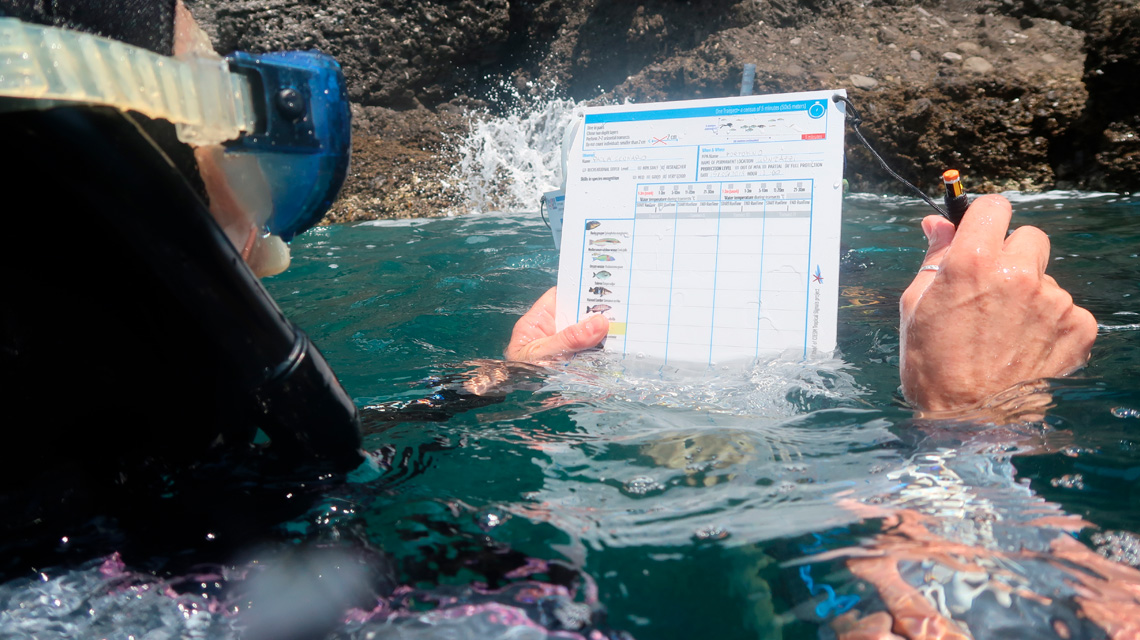Italian National Agency for New Technologies, Energy and Sustainable Economic Development

Climate: Mediterranean, first database of fishes as climate change sentinels
ClimateFish[1] is the first open-access database that provides information on the presence in the Mediterranean Sea of 15 species of fish considered as 'sentinels' of climate change. The research, published in Frontiers, was conducted by marine biologist Ernesto Azzurro at the Institute for Biological Resources and Marine Biotechnology of the CNR, in collaboration with ENEA experts at the Santa Teresa Research Center (La Spezia) and other international institutes.
The database includes seven autochthonous species[2], selected for their wide distribution, sensitivity to temperature and easy identification, and eight exotic species from the Red Sea[3].
“Thanks to underwater samplings taken in over 13 years, more than 100,000 specimens of the 15 target species were recorded in over 3,000 areas in seven countries of the Mediterranean basin, mostly the autochthonous species donzella pavonina and salpa, even if the latter has been recording a decrease in quantity and geographical distribution, most likely due to raising temperatures and competition with tropical herbivores", explained Federica Pannacciulli, head of the ENEA Laboratory of Biodiversity and Ecosystem Services.
Currently, exotic species are still underrepresented in the database and their presence is mostly concentrated in the eastern Mediterranean, most affected by the warming phenomenon, like the area south of Crete (+1.65° C). "But their number is expected to grow in the coming years due to the increase in temperature caused by climate change," continued Pannacciulli.
Approximately 700 fish species and a warming rate about three times faster than that of the ocean, make the Mediterranean a hotspot for both biodiversity and climate change. In recent decades, several species have moved towards the poles, increasing the risk of extinction, while the arrival of new exotic herbivorous species such as rabbitfish is causing marine desertification. Furthermore, several species have widened their geographical distribution in the Mediterranean: it’s a phenomenon referred to as southernization, which involves several native fish species, like the Mediterranean parrotfish and the pavonina damsel, spread northward considering their original geographical distribution.
Evidence of tropicalization was also detected, i.e. presence of non-native fish of tropical origin expected to become increasingly present in the Mediterranean due to global warming (in 2002 there were 90, of which 59 from the Red Sea, while in 2020 the exotic species reached 188 of which 106 from the Suez Canal, for a total of 76 stable species). “The first evidence of northward expansion of some fish species dates back to the 1990s. The phenomenon occurred a decade after detecting a sharp increase in temperature and important changes in the circulation of water in the Mediterranean Sea”, pointed out Pannacciulli.
In addition to the underwater censuses conducted for ClimateFish, the international research team interviewed over 500 fishermen in 95 locations in nine different European countries, aged between 28 and 87, with more than 10 years of individual experience and over 15,000 years of sea observation, to learn about the changes in the Mediterranean eco-system.
Respondents were asked to name the species that has increased in abundance or is perceived as new, i.e. never observed before, in their fishing grounds. Overall, the respondents mainly mentioned 75 species, both native and exotic, adapted to the heat. Two-thirds of the non-native species detected were spotted pufferfish and flutefish. Among the autochthonous species most expanding towards the north, bluefish and Mediterranean barracuda.
“These innovative methods allow us to monitor some effects of climate change on Mediterranean coastal ecosystems in a simple and coordinated way. One of the keywords of this approach is collaboration not just among research institutes but also between researchers and local communities, especially fishermen and diving centres. Furthermore, the approach works well both at the local level and for an entire geographical region like the Mediterranean basin, today considered a climate change hot-spot", said Ernesto Azzurro at the Institute for Biological Resources and Marine Biotechnology of the Cnr.
Photos and Videos
For more information:
Notes
[1] The ‘ClimateFish’ project was initially initiated by the international program ‘CIESM Tropical Signals’ (funded by the Albert II of Monaco Foundation) and later supported by the Interreg Med Programme, co-funded by the European Regional Development Fund.
[2] Epinephelus marginatus (coarse grouper), Thalassoma pavo (peacock damsel), Sparisoma cretense (parrotfish), Sarpa salpa (salpa), Serranus scriba (shark), Serranus cabrilla (perch) and Caranx crysos (golden trevally)
[3] Fistularia commersonii (flutefish), Siganus luridus (dark rabbitfish), Siganus rivulatus (marbled cigarfish), Pterois miles (scorpionfish), Stephanolopis diaspros (reticulated monkfish), Parupeneus forsskali (Forskkal mullet), Pempheris rhomboidea and Torquigener flavimaculosus ( puffer fish)
